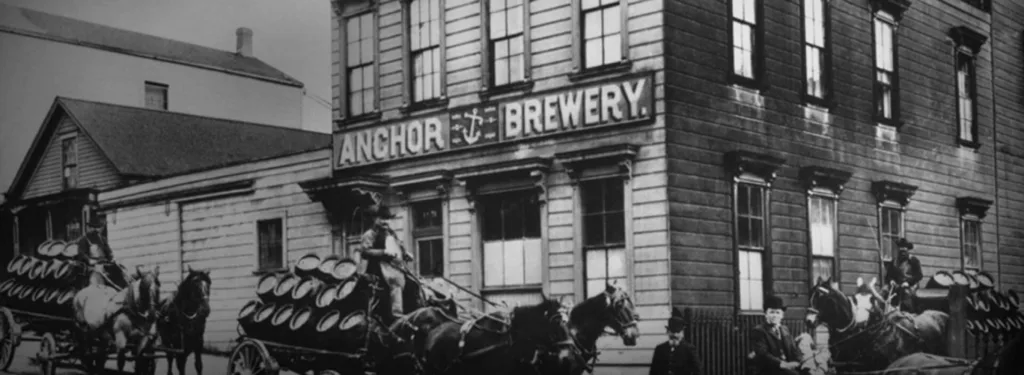The Closure Of Anchor Brewing Company: Impact On The Craft Beer Industry

Table of Contents
Anchor Brewing's Legacy and its Significance in the Craft Beer Market
Anchor Brewing, founded in 1896, holds a unique place in American brewing history. Far beyond simply producing beer, Anchor played a pivotal role in the craft beer revolution of the late 20th century. Its innovative brewing techniques and commitment to traditional brewing styles helped redefine what craft beer could be.
- A Pioneer of the Craft Beer Movement: Anchor was one of the first craft breweries to successfully distribute its beer nationally, establishing a template for future success.
- Revival of Traditional Styles: The brewery's dedication to reviving and perfecting classic beer styles, like its iconic Anchor Steam Beer, set a new standard for quality and authenticity.
- Shaping Beer Styles: Anchor's influence extended to the development of popular styles like the West Coast IPA, setting benchmarks for hop intensity and bitterness that are still felt today.
- A Cultural Icon: Anchor Steam Beer became a symbol of San Francisco and a beloved beverage for generations of beer drinkers.
This legacy makes the closure of Anchor Brewing Company even more poignant and significant for the entire craft beer community.
Financial Factors Contributing to the Closure of Anchor Brewing
While Anchor’s history is illustrious, its recent financial struggles paint a different picture. Several factors contributed to the brewery's downfall:
- Rising Costs: Increased production costs, including raw materials, labor, and distribution, squeezed profit margins. Supply chain disruptions exacerbated these challenges.
- Intense Competition: The craft beer market has become increasingly crowded, with larger breweries and an influx of new craft brands competing fiercely for market share. Anchor struggled to maintain its position in this competitive landscape.
- Shifting Consumer Preferences: Consumer tastes are dynamic. The rise of hazy IPAs and other trendy styles shifted demand away from some of Anchor's traditional offerings. The brewery struggled to fully adapt to these changing preferences.
- The Impact of COVID-19: The pandemic significantly disrupted the hospitality industry, impacting on-premise sales, a crucial revenue stream for many breweries, including Anchor.
These combined factors created a perfect storm, ultimately leading to the difficult decision to close the brewery.
The Impact of Anchor's Closure on the Craft Beer Landscape
The closure of Anchor Brewing Company has sent ripples throughout the craft beer industry. Its impact is multifaceted:
- Loss of a Major Player: The disappearance of such a significant brand represents a substantial loss of market share and brand recognition.
- Economic Fallout: Job losses for Anchor employees and related businesses, such as distributors and suppliers, are a direct consequence of the closure.
- Industry Sentiment: The closure has raised concerns about the stability and future of the craft beer sector as a whole, prompting introspection about sustainability and long-term viability.
- Increased Pressure on Smaller Breweries: The closure intensifies competition for the remaining breweries, forcing them to adapt and innovate to survive.
The event serves as a stark reminder of the challenges inherent in the craft beer market.
Lessons Learned and the Future of Craft Brewing
The closure of Anchor Brewing Company provides valuable lessons for the craft beer industry:
- Adaptability is Key: Staying relevant requires constant adaptation to changing consumer preferences and market trends. Breweries need to be agile and responsive to new styles and demands.
- Sustainable Business Models: Profitability and sustainability must go hand-in-hand. Efficient operations, cost control, and diversified revenue streams are crucial for long-term success.
- Community and Brand Loyalty: Cultivating strong brand loyalty and engaging with the community are vital for weathering market fluctuations and maintaining customer support.
- Innovation and Niche Markets: Exploring innovative brewing techniques and targeting niche markets can help craft breweries differentiate themselves and secure a loyal customer base.
Understanding these lessons is vital for the survival and prosperity of the craft brewing sector.
Conclusion: Understanding the Closure of Anchor Brewing Company and its Long-Term Effects
The closure of Anchor Brewing Company resulted from a complex interplay of financial challenges, intense competition, and shifting consumer preferences. This event underscores the vulnerabilities within the craft beer industry and its need for adaptation and innovation. The loss of this historical landmark serves as a powerful reminder of the fragility of even the most iconic brands. Understanding the closure of Anchor Brewing Company, analyzing the impact of the closure of Anchor Brewing, and studying the future of craft beer after the Anchor Brewing closure are crucial steps in ensuring the long-term health and sustainability of this vibrant sector. We encourage you to delve deeper into the history of Anchor Brewing and the ongoing challenges faced by the craft beer industry to better appreciate this significant event and its lasting implications.

Featured Posts
-
 Bp Ceo Aims To Double Company Valuation Remains Committed To Uk Listing
May 22, 2025
Bp Ceo Aims To Double Company Valuation Remains Committed To Uk Listing
May 22, 2025 -
 Klopp Mu Ancelotti Mi Real Madrid Icin Teknik Direktoer Secimi Tartismasi
May 22, 2025
Klopp Mu Ancelotti Mi Real Madrid Icin Teknik Direktoer Secimi Tartismasi
May 22, 2025 -
 Ex Tory Councillors Wifes Racial Hatred Tweet Appeal The Wait Continues
May 22, 2025
Ex Tory Councillors Wifes Racial Hatred Tweet Appeal The Wait Continues
May 22, 2025 -
 Dealers Double Down Fighting Back Against Ev Mandates
May 22, 2025
Dealers Double Down Fighting Back Against Ev Mandates
May 22, 2025 -
 Abn Group Victoria Awards Media Account To Half Dome
May 22, 2025
Abn Group Victoria Awards Media Account To Half Dome
May 22, 2025
Latest Posts
-
 Blake Lively Faces Legal Trouble Details Of The Justin Baldoni Lawsuit
May 22, 2025
Blake Lively Faces Legal Trouble Details Of The Justin Baldoni Lawsuit
May 22, 2025 -
 Blake Lively Isolated Sisters Rally After Reported Fallout With A List Pals
May 22, 2025
Blake Lively Isolated Sisters Rally After Reported Fallout With A List Pals
May 22, 2025 -
 Latest Updates Blake Lively Justin Baldoni Lawsuit And Celebrity Subpoenas
May 22, 2025
Latest Updates Blake Lively Justin Baldoni Lawsuit And Celebrity Subpoenas
May 22, 2025 -
 Blake Lively Film Controversy The Justin Baldoni Lawsuit Explained
May 22, 2025
Blake Lively Film Controversy The Justin Baldoni Lawsuit Explained
May 22, 2025 -
 Blake Lively Film Controversy Lawsuit Subpoenas And All The Details
May 22, 2025
Blake Lively Film Controversy Lawsuit Subpoenas And All The Details
May 22, 2025
